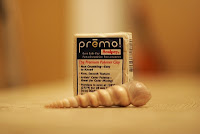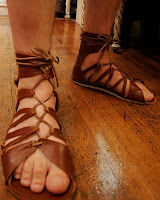Portable solar rigs like those from
Voltaic and
Reware are truly cool. As are smaller gadgets like the
Solio and things with built in charging systems like the
LightCap. They also tend to be expensive. With solar cells becoming increasingly ubiquitous and cheaper every day, it's easy enough to scrounge some up and build your own portable solar projects.
If you are using pre-made solar cells the tech is pretty simple. You can make your own cells but I wouldn't recommend it. So, find some cells laying around and dig in. It's just basic wiring and relatively safe DC power. There isn't all that much to it. You can buy photo-voltaic cells on the web and at places like Radio Shack or reclaim them from broken road signs, yard lights or every solar powered calculator in your neighborhood dollar store. Maybe ignore that last option... unless you really like to do delicate soldering.
I got some great
polycrystaline cells from a Volkswagon dealership! They were shipped with the cars to prevent the batteries from going dead from factory to dealership. They are designed to plug into the OBD2 diagnostic port. In this case, two of those units live on and get used far more often than they were intended. Poly-crystalline cells have a lot shorter lifespan than the more expensive mono-crystalline cells but even if they conk out after 4-5 years of continuous use I'll be in good shape. I don't use them constantly anyway. Ultimately they are good for simple apps like portable solar but maybe not so great to cover the roof of your house. As far as I can tell these are meant to be throw away cells once they reach the dealership.
Cars should probably all have this tech built into their superstructure anyway. Even if consumers don't like the look it's not difficult to hide functional cells in plain site as trim and accent pieces. Either way, the consumer will like the added feature of a self tending battery that charges while the car is off. It also makes sense to be able to continue to put a small amount of power into a car battery even when the engine has broken down. It could be used to power hazard flashers, the radio or possibly a socket plug to charge a life saving cell phone... but back to the project at hand.
Once you have your photo-voltaic cell you'll need to make sure it has a couple of wires (leads) coming off so you can put it to use. If it doesn't you may have to gently solder some on. This is delicate because it's easy to damage cells with the heat from a soldering iron. So, be gentle and be quick. Some cells may have an intimidating looking dog ear plug or other complex contraption sticking out of them. Fear not, there are still just two wires inside that thing coming from the cell itself.
You may want to grab an ohmmeter, put your cell in full sun and see what kind of power it's putting out. If you feel it's too much to risk your MP3 player, cell phone or game gadget you could wire in a resistor that will limit the power going to the device. This is probably not necessary but that's a decision for you to make. You can buy resistors or pull them from old electronics. It will take quite a solar array to charge something even as small as a laptop, so in most cases this will just be overkill. The point I'm making is that solar is often so simple even someone with relatively no electronics skills or education can put together useful projects.
I got lucky with my ICP Solar Technologies cells because they already have a battery charge controller installed. I also have solid specs on the output (Voc: 23V, Isc: 296 mA, Pmax: 4.3W, Vmp : 18V, Imp : 240mA) but it's not all that important for my application. So, in this case I just lopped off the offending OBD2 plug and wired in a lighter socket from Radio Shack. This allows me to charge anything that you could charge with a standard car charger. I've charged my PDA, iPod, camera batteries and even manged to charge my vintage Sony Vaio (an early PCG C1X). The set up easily straps to a messenger bag, backpack or the top of a stroller, yet another item that should come equipped with a solar charging array.
If one of the major issues with going solar is that it won't scale to power the grid, then maybe we should look into abandoning the grid? It's a good time to go out and hack yourself a portable solar rig!
Note, the photo is of an identical unit produced by ICP for Nissan. Image via
http://www.earth2tech.com/
 After a protracted struggle of my own that included busted knuckles and a fair bit of frustration I finally sent the bike off to the experts at O'Hanlon's Motorcycles hidden down in SOMA. Then after a grueling wait that stretched on and on as even the experts got frustrated the problem was finally tracked down.
After a protracted struggle of my own that included busted knuckles and a fair bit of frustration I finally sent the bike off to the experts at O'Hanlon's Motorcycles hidden down in SOMA. Then after a grueling wait that stretched on and on as even the experts got frustrated the problem was finally tracked down.









.JPG)















